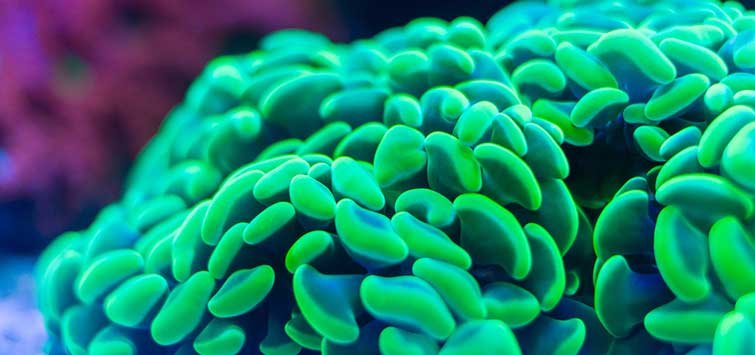With your interests lying in being an avid aquarist or hobbyist of a reef tank, you have necessarily seen the stunning look of the lps hammer coral. These corals have also long been sought after by marine aquarium hobbyists for different valid reasons.
These include their vibrant colors, distinctive hammer-shaped tentacles, and less-than-demanding care requirements. We are going to take you through everything that you need to know about LPS Hammer Corals in this article.
So, if you want to know where they live in nature and how to care for them in a tank, you need to benefit from this content. This will help you make an informed choice, as you will know that you are doing your best by adding these incredible corals to your underwater world.
What Are LPS Hammer Corals:
LPS stands for “Large Polyp Stony” corals, which are corals with fleshy, usually colored polyps and a hard calcium carbonate skeleton. Hammer corals fall under this category since they possess waving, large tentacles that resemble the head of a hammer and hence are referred to as hammer corals.
They are available in every color from purple, gold, and green to bicolored. They add a bit of movement with their waving tentacles. These also introduce an element of nature and beauty to reef tanks.
Natural Habitat:
The LPS Hammer Corals live in the Indo-Pacific, specifically in the Australian, Indonesian, and Fijian Oceans. They like living in shallow reef slopes and lagoons with a moderate flow of water and heavy lighting.
Knowing where they originate will help because replicating the same condition in your own home aquarium will make them grow.
Optimum Tank Conditions:
Providing LPS Hammer Corals with their perfect conditions is all about finding the balance of a series of significant variables:
- Lighting: They adore medium light. Bright light will bleach them, yet insufficient light will hinder them. Adjustable intensity LED lights best replicate natural sunlight.
- Water Flow: Moderate water flow is best. It must be firm enough to allow their tentacles to sway gently but not strong enough to crush their soft tissue.
- Water Parameters: Constant water parameters are necessary. Use the following parameters:
- Temperature: 7580°F (2427°C)
- Salinity: 1.025 specific gravity
- pH: 8.18.4
- Calcium: 400450 ppm
- Alkalinity: 812 dKH
- Magnesium: 12001350 ppm
Feeding And Nutrition:
Even though lps hammer coral hosts symbiotic algae in its body tissues, it exchanges nutrients with them through the process of photosynthesis. These also accept supplemental feeding. You need to feed them with the help of different supplements once or twice a week using tiny meaty foods such as:
- Mysis shrimp
- Brine shrimp
- Reef roids or coral foods
Target feeds the coral with a turkey baster or coral feeder so that food will fall on its tentacles.
Tank Placement:
Correct placement should be made to prevent aggression and encourage optimal health. Hammer corals have “sweeper tentacles” that can extend a few inches, especially at night, and sting surrounding corals.
Do not put them close to other corals in the event they fight, and a minimum of 6 inches is safe. They prefer to do well in the center or bottom of the tank, depending on your lighting setup.
Other Marine Life Compatibility:
LPS Hammer Coral is semi-aggressive because it has stinging tentacles. As a result of this, tank mates must be carefully planned. They get along very well with other Euphyllia species like frogspawn or torch corals because they can share without injuring them.
Avoid putting them near soft corals and Acroporasensitive corals because their sting is toxic enough to cause harm to tissues. Fish, and reef-safe animals like clownfish, gobies, and tangs do not harm hammer corals.
Common Problems And Solutions:
Despite proper care, lps hammer coral will also be subjected to a few issues that will crop up. Below is how one should handle the most common issues:
- Tissue Recession: Usually the result of water quality problems or obnoxious tank mates. Keep your parameters consistent and rehome any obnoxious neighbors.
- Brown Jelly Disease: Bacterial disease in the form of brown, syrupy slime. In extreme cases, removal of the affected coral, water changes, and antibiotic therapy may be warranted.
- Bleaching: Usually caused by overlighting or temperature swings. Tweak your lighting and stabilize your tank temperature.
You should be careful about these common problems before opting for these corals for your reef tank.
Why Add LPS Hammer Corals To Your Reef Tank:
LPS Hammer Coral is a great addition to any reef tank because of the following:
- Aesthetic Value: Their flowing, hammer-shaped tentacles create movement and visual appeal.
- Easy Care Level: This is not for beginners, but it is more easily maintained than some SPS (small polyp stony) corals.
- Interaction: Many aquarists that keep reefs have fun watching the clownfish associate with these corals like they do their anemones.
All these reasons are persuasive enough to get LPS hammer corals for your reef tank. Don’t you think that all these are great reasons to opt for LPS Hammer corals for your reef tank? If this is your first time setting up a tank, you need to give them a try.
This will help you enjoy the best reef-keeping experience ever. The addition of LPS Hammer Corals to your reef tank is a combination of adding beauty as well as intrigue to your water setup. Creating their natural home, having healthy water conditions, and correct placing will give life to these phenomenal corals so they can be at their very best.
Conclusion:
Get ready to take your reef tank to new heights of elegance with the entrancing dance of LPS Hammer Corals. With a little proper care and handling, they will soon be a denizen of your aquatic realm.




